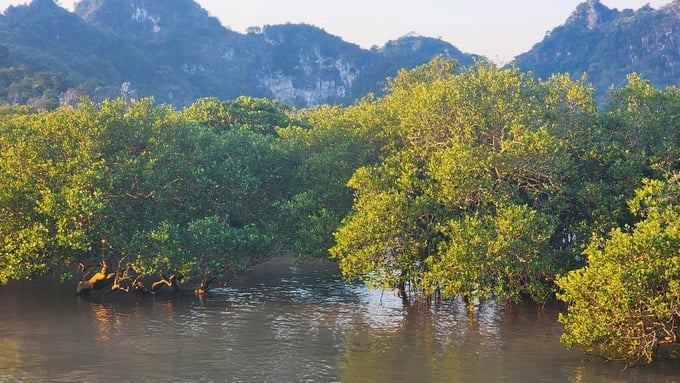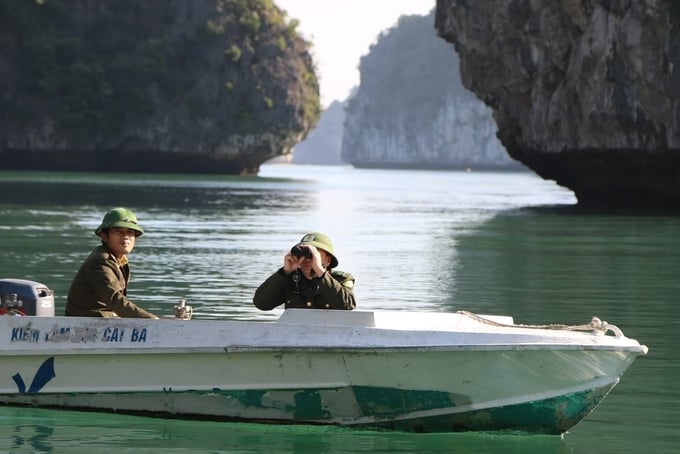November 26, 2025 | 09:35 GMT +7
November 26, 2025 | 09:35 GMT +7
Hotline: 0913.378.918
November 26, 2025 | 09:35 GMT +7
Hotline: 0913.378.918

The mangrove ecosystem in Xuan Dam Commune, Cat Hai District. Photo: Dinh Muoi.
According to the Hai Phong City's Department of Agriculture and Rural Development, a team of experts from the Korean Forest Service (KFS) recently visited Hai Phong City to conduct research and assess potential projects related to the restoration and sustainable management of mangrove forests.
The project "Restoration and Sustainable Management of Mangrove Forests in the Red River Delta," funded by KFS through a non-refundable aid program, has been implemented in the provinces of Nam Dinh and Ninh Binh from 2021 to 2024. This initiative has achieved its objectives and met the goals set by both governments. Consequently, KFS has expressed interest in exploring new project ideas in Northern and Central coastal provinces, including Hai Phong City.
In response to this proposal, Hai Phong City's Department of Agriculture and Rural Development accompanied the Korean experts to potential project sites in Cat Hai District during their visit to the city. Additionally, Hai Phong has requested KFS's support in implementing key measures for mangrove forest restoration and development.
For equipment, the Department has requested pickup trucks for forest patrol, protection, and fire prevention activities; patrol boats for the same purposes; as well as computers and printers.
For larger projects, the Department proposed the construction of wave-dissipating soft barriers and sedimentation platforms to restore and protect mangrove forests in the Phu Long tidal flats area. Other requests include the establishment of a temporary nursery for seedling production, five hectares of new mangrove forest, 40 hectares of supplementary mangrove forest area, and the installation of three forest protection observation towers. Additionally, the Department seeks support in developing livelihood improvement models for the local communities involved in sustainable forest management, such as beekeeping, mangrove ecotourism, and integrated forestry and aquaculture models.

Hai Phong has also requested KFS to support the provision of patrol boats for forest protection if the project is implemented. Photo: Dinh Muoi.
Hai Phong City is located in the lower reaches of the Thai Binh River system, with five major river mouths flowing into the sea: Thai Binh, Van Uc, Lach Tray, Cam, and Nam Trieu. The city currently houses over 151,000 hectares of natural forest area.
Hai Phong encompasses more than 24,000 hectares of coastal mudflats, including approximately 12,400 hectares of high-tide flats, 5,500 hectares of mid-tide flats, and 6,100 hectares of coastal sandbanks. The mangrove species in Hai Phong's coastal region are primarily located in seven coastal districts: Thuy Nguyen, Kien Thuy, Tien Lang, Cat Hai, Do Son, Duong Kinh, and Hai An. Over the years, Hai Phong City has received recognition for its significant tidal flats and mangrove forest potential.
Despite this potential, the mangrove forests in Hai Phong are currently at risk of both declining in area and in quality, failing to fully fulfill their vital role in environmental and social protection.
Moreover, the expansion of coastal aquaculture and the uncontrolled exploitation of natural aquatic resources within the mangrove forests are affecting ecological balance and depleting natural coastal fish stocks. Consequently, the project, if implemented with the necessary support, can potentially restore a considerable area of mangrove forests, thereby contributing to national security and enhancing coastal defense capabilities.
In 1989, Hai Phong's coastal region boasted approximately 3,270 hectares of mangrove forest. By 2007, this figure had decreased to 1,943 hectares with an ongoing steady decline. The reduction in mangrove forest area was caused by deforestation for rice production, aquaculture, resettlement, urbanization, and the development of economic zones. The most significant losses have occurred in Dinh Vu, Cat Hai, and Thuy Nguyen.
Tien Phong Newspaper recently planted 1.12 hectare of new mangrove forests in the K15 Pier, Do Son District, in a series of environmental protection activities titled 'The Green Dream.'
Accordingly, Tien Phong Newspaper, in collaboration with Hai Phong City's Department of Agriculture and Rural Development, launched a response to protect mangrove forests in K15 Pier, Do Son District, Hai Phong City on the morning of August 12.
At the event, Tien Phong Newspaper presented 2,600 trees, including 1,300 mangrove trees and 1,300 trang trees, to Hai Phong City's Department of Agriculture and Rural Development. These two native tree species boast strong growth and resistance to local soil and climate conditions.
Translated by Nguyen Hai Long
/2025/11/24/3536-2-112800_176.jpg)
(VAN) Dong Nai now has tens of thousands of hectares of forests certified for sustainable management, and this area will continue to be expanded in the coming period.

(VAN) Vinh Ha hamlet (Dai Xuyen commune, Hanoi) is shifting away from small-scale farming as households adopt bioscurity into their breeder chicken models.

(VAN) Heavy rains make aquatic species more vulnerable to disease. Proactive water management and high-tech systems help farmers prevent outbreaks and protect yields.

(VAN) Greenhouses are shifting production mindsets in Binh Lu commune, enabling farmers to ‘weather the sun and rain’ and secure stable vegetable harvests throughout the year.

(VAN) Green transition is crucial for the Mekong Delta amid climate change and stricter standards, offering a path toward sustainability.

(VAN) Dong Thap promotes agricultural restructuring, forms large specialized farming zones, raises the value of agricultural products and develops toward ecological and high-tech directions.
/2025/11/22/4018-4-213342_747.jpg)
(VAN) The Mekong Delta Agricultural Experts Club has attracted 143 experts and researchers to participate in providing consultancy and contributing initiatives to the development of one million hectares of high-quality rice.